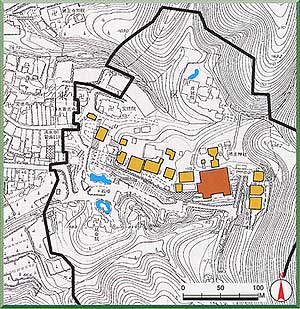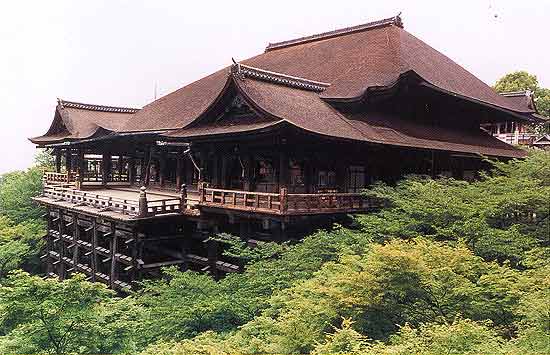| JAPANESE | |
| D. Kiyomizu-dera | |
| The beautiful buildings which match with the scenery of Higashiyama (east mountains) | |
| Establishment: The late 8th century | |
| According to the tradition, Kiyomizu-dera originated in778 when the monk
Enchin enshrined an image of Kannon on mountain overlooking the Otowa-no-taki Falls;
later in 798, the general Sakanoue no Tamuramaro built a Budda hall there,
fllowing which Kiyomizu-dera came under the official partronage of Emperor
Kanmu. Repeatedly destroyed by fire over the centuries, it was rebuilt
on each occasion. Today, the principal temple buildings are the Saimon
(west gate), the Sanjunoto (three-storied pagoda), the Kyodo (sutra hall),
the Tamurado (founder's hall), the Todorokimon (middle gate), the Asakurado
Hall, the Hondo (main hall) and the Amidado (Amida Buddha hall), all aligned
on an east-west. Around them are other temple buildings, including the
Niomon (gate of Deva Kings), the Umatodome (hitching stables), the Shoto
(belfry), the Shakado (Shakyamuni hall), the Okunoin (innermost temple),
the Koyasudo Pagoda, the Chinjudo and the Jishu-jinja which enshrines the
tutelary deity. The Hondo, built in 1633, is the central of the temple compound and is anexample of kakezukuri or "overhang" architecture. It is famous for its so-called "Kiyomizu-dera stage", an imposing veranda supported by tall wooden columns with wooden braces running through them crosswise and lengthwise. In addition, the eastern part of the temple contains the Joju-in Garden, which incorporates the "borrow scenery" (shakkei) in the early Edo Period. |
 |
 |
|
| Photo by Kanzaki Junichi | |
Map of "Historic Monuments of Ancient Kyoto" |
|